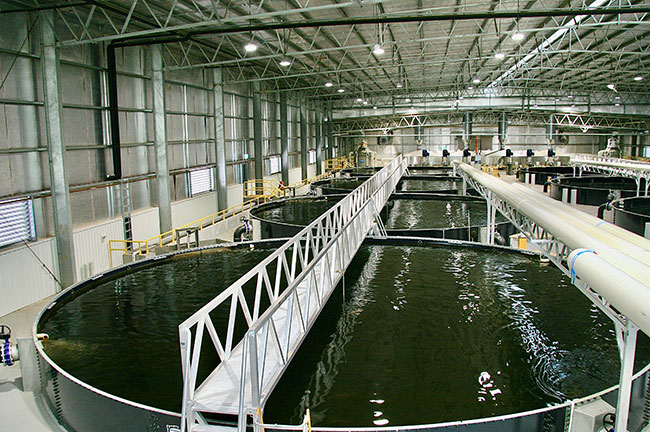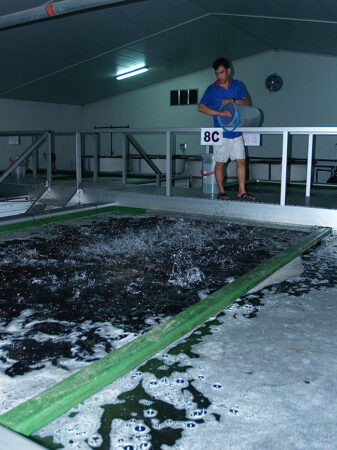
Features
Viewpoint: RAS in Oz
Looking down under to Australia’s potential for recirculating aquaculture
March 11, 2024 By John Mosig
 Modern RAS farm is capable of continuous production of a consistent product, and back that up with market.predictability
Photos: John Mosig
Modern RAS farm is capable of continuous production of a consistent product, and back that up with market.predictability
Photos: John Mosig There is no doubt now that climate change is real and has caught many governments and industries off guard. The recent Northern Hemisphere horror summer has driven home the threat to our way of living and the need to future-proof our food supply chains.
Our oceans and freshwater systems, being the sumps for all the water-soluble pollutants of modern living are extremely vulnerable to contamination. Furthermore, they absorb huge amounts of CO2 and energy. This increases their acidity and temperature. Once these two factors reach critical levels, the productivity of aquatic organisms becomes problematic. Data coming through from research sensors stationed around the globe suggest a highly compromised oceanic environment is unavoidable. This puts aquaculture on the frontline of the battle to maintain food supplies for the three billion people who rely on seafood as their major source of protein.
Australia has experienced similar extreme fire and flood events over the last ten years, with the height of the Covid pandemic in the middle of it all. One answer to the looming threat has been around since the 1990s. Recirculating aquaculture systems (RAS) provide biosecurity, a controlled environment and waste recycling capacity. As advantageous as this appears on paper, success has been elusive. The reasons are many.
The first systems came to Australia from Europe. Based on sewerage treatment plants, a lot of the early engineering focussed on treating the water, which in itself is not a bad thing, but the cost of production per kilo was high. Species such as eels (Anguilla sps.), Murray cod (Maccullochella peelii peelii) and barramundi (Lates calcarifer) had a following in the wet markets and proved to be profitable.
An added advantage was the RAS farms could be strategically situated in an industrial estate close to markets. Furthermore, Fisheries officers, burdened with the permit issues of biosecurity and genetic integrity associated with open systems, embraced the new closed technology because they ticked all the regulatory boxes. It was all systems go. This itself became a problem.
The 1990s were a vibrant time for aquaculture in Australia. Growing fish to replace the regulated harvest from the wild fishery was seem as the future and everyone wanted to get in on the act. Upscaled aquarium systems appeared on the market and were sold to those with insufficient funds to import and operate the commercial scale European models. RAS operations popped up in farm sheds and double garages in suburbia. Extravagant production claims were made to justify the outlay and the running costs. Naïve buyers, caught up in the gold rush fever of the time, swallowed the “black box” technology and Fisheries departments, spurred on by the flood of annual permit fees and research requirements the influx of foot soldiers stimulated, couldn’t issue the permit’s quick enough.
The RAS kits came with construction and operational manuals but sadly what was missing in the instructions was Aquaculture 101: water is a dynamic and volatile environment. More bells and whistles were added to manage problems as they arose, and to be fair, quite a few operators knuckled down and made them work. But the small-scale systems producing 5-10 tonne of fish a year were never going to be economic outside local outlets or farmers’ markets, and while 20-50 tonne family-run farms were profitably producing fish, any gain was negated by the time involved.

The FishProtech systems, designed by Johan Don, were the first commercial systems built in Australia.
One broiler producer who had invested in RAS said, “There were times when I slept on a bunk in the shed during batch changeovers, but you almost needed a permanent bed beside the fish tanks”. One by one, they drifted away from aquaculture, wiser from the experience.
Looking back at today’s RAS sector it’s hard to imagine the magnitude and variations of RAS technology and the aquaculture businesses it spawned back in those times. From hydroponics hybrids to visa application investment schemes, they all had their time in the sun.
Not all the technology was overblown. The European engineering was sound and the understanding of what was required to make the systems fish friendly and risk averse soon began to emerge. Again, looking back, it was well short of what drives the sector today, but it was based in science and biology and considered the economics. It worked.
The premise of RAS is irrefutable. Biosecurity and 24/7 optimum and controllable growing conditions made a highly efficient fish farming environment. Market predictability and traceability attracted professional investors with managed capital and glossy business plans. While some were more gloss than grist, the sector started to stabilise. By the turn of the century, there were several outfits reliably selling 50-100 tonnes of fish into the market, particularly the wet markets that by this time were supplying a strong demand from the growing Asian diaspora.
The margins weren’t high, but they were healthy. On paper. What was high was the risk factor. Water quality is stable until it isn’t. Any operator who failed to read warning trends from the monitored data found themselves facing catastrophe. Worst of all, the most vulnerable tanks tended to be the tanks of the most advanced fish on the farm; the ones that had eaten the most food and taken the most effort to raise. Not only could growers lose a year’s profit overnight, they had to explain to their customers that there’d be no product for a month or so. One by one, this cohort of RAS farms either closed or sold their marginal systems on until eventually that cohort closed down altogether.
There were two survivors. One, Mark Lee’s Fish Farm, based in Adelaide and one in Melbourne, MainStream Aquaculture. The former’s success was based on the energy and marketing acumen of its founder; the latter on the scientific vision of its founder, Dr. Paul Harrison. Mark grows around 120 tonnes of barramundi in a FishProtech system designed by RAS pioneer Johan Don back in 1997, and supplies wet markets with live fish along the eastern seaboard capitals. He and son Jack supplement this income with a wide range of seafood products.
Paul incorporated the new RAS water quality management technology as it became available. These efficiencies allowed him to stabilize production and expand market share. They had their own hatchery and he foresaw the huge potential in improving the performance of the fish they stocked. By removing limiting factors from their system, they were able to monitor and maximize genetic potential. MainStream embarked on a family-based selection program that has them supplying 70 per cent of the local barramundi seedstock requirement and 30 per cent of the global market.
The other major users of RAS technology in Australia are hatchery operators. West Beach Aquaculture rears barramundi fry in the original FishProtech system built in Australia for their flowthrough growout farm using artesian water, and the salmon growers of Tasmania. Being able to condition broodstock and raise smolt under climate-controlled conditions has been a major economic boost to the sector that now produces 86,000 tonnes a year, with its sights on 90,000 tonnes by the end of the decade.
While RAS has reached a level of sophistication far beyond its early days in Australia, its acceptance has been selective. Nearly all the finfish are still produced in open systems. However, this could be about to change. The Leeuwin and East Australian Currents that brush the west and east coasts are both global marine hotspots, and the continent is particularly vulnerable to the ENSO and IOD weather patterns.
If any country should be looking at RAS farming to secure its seafood supplies, it’s Australia.
John Mosig is considered one of the pioneers of Australian warmwater aquaculture. His 43 years of experience at a commercial level has given him a clear understanding of the economic drivers of the industry. He has served on several sector and industry peak bodies. He has designing and delivering training programs and written two books on the subject, both published by CSIRO Publishing. (mosig@netspace.net.au)
Print this page